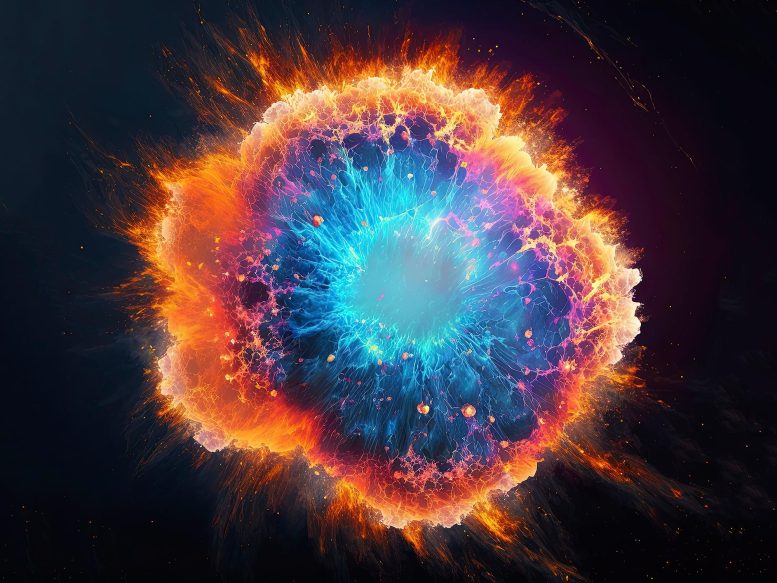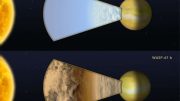
Groundbreaking observations by a Cornell-led team reveal repeated energetic flares from a stellar corpse following a star’s explosion, challenging existing theories about stellar deaths and highlighting the possible role of black holes or neutron stars in such rare, intense phenomena.
A distant star’s explosive demise left behind an active stellar corpse, which is believed to be the source of multiple energetic flares detected over several months. This occurrence, a phenomenon astronomers had never seen before, was reported by a team led by Cornell University in a study recently published in the journal Nature.
The bright, brief flashes – as short as a few minutes in duration, and as powerful as the original explosion 100 days later – appeared in the aftermath of a rare type of stellar cataclysm that the researchers had set out to find, known as a luminous fast blue optical transient, or LFBOT.
Since their discovery in 2018, astronomers have speculated about what might drive such extreme explosions, which are far brighter than the violent ends massive stars typically experience, but fade in days instead of weeks. The research team believes the previously unknown flare activity, which was studied by 15 telescopes around the world, confirms the engine must be a stellar corpse: a black hole or neutron star.
A Unique Astronomical Event: AT2022tsd
“We don’t think anything else can make these kinds of flares,” said Anna Y. Q. Ho, assistant professor of astronomy in the College of Arts and Sciences. “This settles years of debate about what powers this type of explosion, and reveals an unusually direct method of studying the activity of stellar corpses.”
Ho is the first author of a recent study published with more than 70 co-authors who helped characterize the LFBOT officially labeled AT2022tsd and nicknamed “the Tasmanian devil,” and the ensuing pulses of light seen roughly a billion light-years from Earth.
Ho wrote the software that flagged the event in September 2022, while sifting through a half-million changes, or transients, detected daily in an all-sky survey conducted by the Califrnia-based Zwicky Transient Facility.
Then in December 2022, while routinely monitoring the fading explosion, Ho and collaborators Daniel Perley of Liverpool John Moores University in England, and Ping Chen of the Weizmann Institute of Science in Israel, met to review new observations conducted and analyzed by Ping – a set of five images, each spanning several minutes. The first showed nothing, as expected, but the second picked up light, followed by an intensely bright spike in the middle frame that quickly vanished.
“No one really knew what to say,” Ho recalled. “We had never seen anything like that before – something so fast, and the brightness as strong as the original explosion months later – in any supernova or FBOT. We’d never seen that, period, in astronomy.”
To further investigate the abrupt rebrightening, the researchers engaged partners who contributed observations from more than a dozen other telescopes, including one equipped with a high-speed camera. The team combed through earlier data and worked to rule out other possible light sources. Their analysis ultimately confirmed at least 14 irregular light pulses over a 120-day period, likely only a fraction of the total number, Ho said.
“Amazingly, instead of fading steadily as one would expect, the source briefly brightened again – and again, and again,” she said. “LFBOTs are already a kind of weird, exotic event, so this was even weirder.”
Implications for Stellar Evolution and Cataclysms
Exactly what processes were at work – perhaps a black hole funneling jets of stellar material outward at close to the speed of light – continues to be studied. Ho hopes the research advances longstanding goals to map how stars’ properties in life may predict the way they’ll die, and the type of corpse they produce.
In the case of LFBOTs, rapid rotation or a strong magnetic field likely are key components of their launching mechanisms, Ho said. It’s also possible that they aren’t conventional supernovas at all, but instead triggered by a star’s merger with a black hole.
“We might be seeing a completely different channel for cosmic cataclysms,” she said.
The unusual explosions promise to provide new insight into stellar lifecycles typically only seen in snapshots of different stages – star, explosion, remnants – and not as part of a single system, Ho said. LFBOTs may present an opportunity to observe a star in the act of transitioning to its afterlife.
“Because the corpse is not just sitting there, it’s active and doing things that we can detect,” Ho said. “We think these flares could be coming from one of these newly formed corpses, which gives us a way to study their properties when they’ve just been formed.”
Reference: “Minutes-duration optical flares with supernova luminosities” by Anna Y. Q. Ho, Daniel A. Perley, Ping Chen, Steve Schulze, Vik Dhillon, Harsh Kumar, Aswin Suresh, Vishwajeet Swain, Michael Bremer, Stephen J. Smartt, Joseph P. Anderson, G. C. Anupama, Supachai Awiphan, Sudhanshu Barway, Eric C. Bellm, Sagi Ben-Ami, Varun Bhalerao, Thomas de Boer, Thomas G. Brink, Rick Burruss, Poonam Chandra, Ting-Wan Chen, Wen-Ping Chen, Jeff Cooke, Michael W. Coughlin, Kaustav K. Das, Andrew J. Drake, Alexei V. Filippenko, James Freeburn, Christoffer Fremling, Michael D. Fulton, Avishay Gal-Yam, Lluís Galbany, Hua Gao, Matthew J. Graham, Mariusz Gromadzki, Claudia P. Gutiérrez, K-Ryan Hinds, Cosimo Inserra, Nayana A J, Viraj Karambelkar, Mansi M. Kasliwal, Shri Kulkarni, Tomás E. Müller-Bravo, Eugene A. Magnier, Ashish A. Mahabal, Thomas Moore, Chow-Choong Ngeow, Matt Nicholl, Eran O. Ofek, Conor M. B. Omand, Francesca Onori, Yen-Chen Pan, Priscila J. Pessi, Glen Petitpas, David Polishook, Saran Poshyachinda, Miika Pursiainen, Reed Riddle, Antonio C. Rodriguez, Ben Rusholme, Enrico Segre, Yashvi Sharma, Ken W. Smith, Jesper Sollerman, Shubham Srivastav, Nora Linn Strotjohann, Mark Suhr, Dmitry Svinkin, Yanan Wang, Philip Wiseman, Avery Wold, Sheng Yang, Yi Yang, Yuhan Yao, David R. Young and WeiKang Zheng, 15 November 2023, Nature.
DOI: 10.1038/s41586-023-06673-6









Such an excitement and live commentary for a past event, which had occurred millions of years ago and currently it must in a phase, which will be unknown for millions of years to its observers in the Solar system.
So what, you effing dolt? We can learn from events in the past, which we are seeing now. Scared that your little goddie of the gaps will have less space to hide in, if we learn more, you dumb nitwit?
Very misleading title….
Just musings but light travels faster that signals. Wouldn’t we be getting the last pulses of a soon to be dead star long after we saw the flash? Something like a nuke, see it, a few moments we watch it, then we hear it and feel it… But on a galactic scale?
Please don’t use “signs of life” in an article talking about the aftermath of a stellar explosion. This discovery is very cool, but had nothing to do with life. I know you’re meaning the life of the star, but the article headline made me think they’d discovered aluen life in the aftermath of a star.